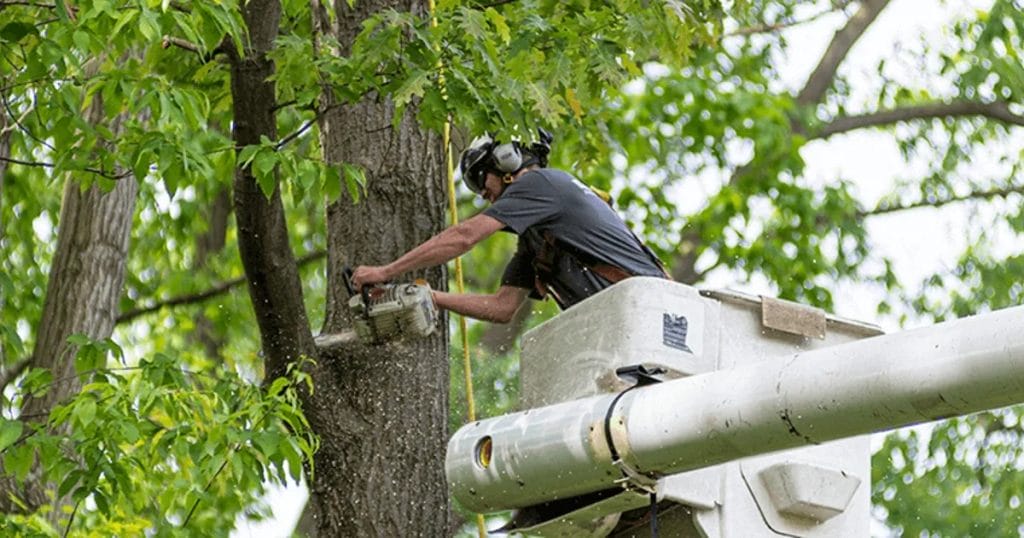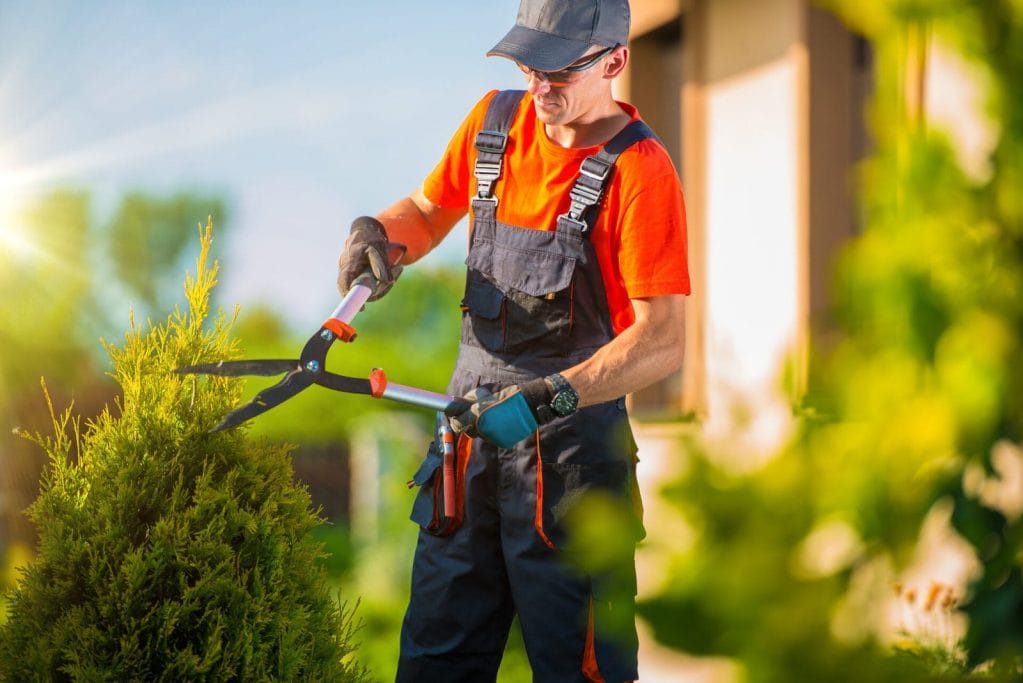
Tree Trimming
Elevate the beauty and health of your trees with Keystone Industries’ exceptional tree trimming services. Our experienced arborists skillfully prune and trim trees to promote their growth, shape, and vitality. We understand the intricate needs of different tree species, ensuring precise cuts that enhance their aesthetics and structural integrity. With a commitment to safety and environmental sustainability, our team utilizes the latest techniques and equipment to provide professional and reliable tree trimming solutions. Trust us to enhance the appeal and longevity of your trees while maintaining the safety of your property. Contact us today for expert tree trimming tailored to your landscape’s needs. Don’t forget to check out our Land Clearing Services
Everything You Need to Know About Tree Trimming
When it comes to maintaining the health and beauty of your trees, tree trimming is an essential practice. Not only does it help promote optimal tree growth, but it also keeps your landscape looking neat and well-maintained. In this article, we will discuss everything you need to know about tree trimming, including its purpose, benefits, timing, techniques, and the importance of hiring certified arborists for tree care.

What is Tree Trimming and Why is it Important?
Tree trimming refers to the process of cutting or pruning tree branches to maintain the tree’s health, shape, and appearance. It involves the removal of dead, diseased, or overgrown branches, as well as shaping the tree to control its growth. Tree trimming is important for several reasons:
Understanding the Purpose of Tree Trimming
One of the main purposes of tree trimming is to ensure the safety of your property and loved ones. By removing dead, diseased, or weak branches, you reduce the risk of them falling and causing damage or injury. Tree trimming also helps to improve the overall health of the tree by promoting new growth and air circulation.
The Benefits of Regular Tree Trimming
Regular tree trimming offers numerous benefits for both the tree and the surrounding landscape. It enhances the tree’s appearance and shape, making it more aesthetically pleasing. Trimmed trees also tend to have healthier foliage and produce more flowers and fruits. Additionally, tree trimming can improve the amount of sunlight reaching the lower branches and other plants beneath the tree, promoting their growth.
How to Identify If Your Trees Need Trimming
There are several signs that indicate your trees may need trimming. Look out for branches that are hanging too low, touching power lines, or obstructing walkways. Dead or dying branches, as well as those showing signs of disease or insect infestation, should also be removed through trimming. Additionally, if your trees are growing too close together or starting to grow into structures, it may be necessary to trim them.
When is the Best Time to Trim Trees and Shrubs?
The timing of tree trimming depends on the type of tree or shrub you are dealing with. In general, however, there are some guidelines to follow:
Pruning Trees in Early Spring
For most deciduous trees, early spring is the best time for pruning. This is when the tree is still dormant, before new growth begins. Pruning during this time allows the tree to efficiently allocate resources to the areas that need it most, promoting better growth during the warmer months.
Pruning Shrubs in Fall or Winter
On the other hand, many shrubs are best pruned in the fall or winter, after they have finished flowering. This allows them to focus on storing energy for the following season and encourages more vibrant blooms.
Factors to Consider When Deciding on the Timing
While these guidelines provide a general framework, there are some factors to consider when deciding on the timing of tree trimming. For instance, if a tree has experienced damage from storms or disease, it may require immediate pruning, regardless of the season. Additionally, certain trees, like oak trees, should only be pruned during specific times to minimize the risk of disease transmission.

How to Properly Trim a Tree for Optimal Health
Trimming a tree may seem like a simple task, but it is important to do it correctly to maintain the tree’s health and prevent damage. Here is a step-by-step guide to help you trim trees properly:
Step-by-Step Guide to Trimming Trees
1. Start by examining the tree and identifying the branches that need to be trimmed. Look for any dead, diseased, or crossing branches.
2. Use the appropriate tools, such as pruning shears or a pruning saw, depending on the size of the branches. It is important to use sharp and clean tools to make clean cuts.
3. Begin by removing the dead or damaged branches first. Cut them at the base, just outside the branch collar.
4. Next, remove any branches that are crossing or rubbing against each other. Cut them back to their point of origin.
5. Step back occasionally to assess the tree’s overall shape and make any necessary adjustments.
6. Avoid cutting large branches that are more than one-third of the tree’s diameter, as this can lead to significant damage and stress on the tree.
The Importance of Proper Tree Pruning Techniques
Proper tree pruning techniques are crucial to maintaining the health and appearance of a tree. When done correctly, pruning promotes the growth of new branches, improves air circulation, and reduces the risk of disease and insect infestation. However, improper pruning can weaken the tree, leave it vulnerable to disease, and result in an unsightly appearance.
Common Mistakes to Avoid When Trimming Trees
When trimming trees, it is important to avoid common mistakes that can harm the tree. These include:
– Topping the tree, which involves cutting off the entire top portion. This can stunt the tree’s growth and make it more susceptible to diseases.
– Cutting too close to the trunk or leaving stubs. This can prevent proper healing and lead to decay.
– Overthinning, which involves removing too many branches, can weaken the tree and affect its structure.
Understanding the Risks and Benefits of Tree Removal
While tree trimming is often enough to maintain tree health, there are cases where tree removal becomes necessary. It is important to understand the risks and benefits associated with tree removal:
When to Consider Tree Removal
Tree removal may be necessary in the following situations:
– The tree is dead or severely diseased, posing a safety risk.
– The tree is causing damage to structures, such as roots invading foundations or branches touching power lines.
– The tree is blocking sunlight and hindering the growth of other plants.
– The tree has been irreparably damaged by storms or other natural events.
Hiring Professional Tree Removal Services
In cases where tree removal is necessary, it is highly recommended to hire professional tree removal services. They have the experience, expertise, and equipment to safely and efficiently remove the tree. They also ensure that the tree is removed completely, including the stump, to prevent regrowth.
How to Minimize the Impact of Tree Removal on the Landscape
Tree removal can have a significant impact on the landscape. To minimize this impact, consider planting a new tree to replace the one that was removed. This helps to maintain the aesthetics of the landscape and provides the same environmental benefits that the previous tree offered.
Working with Certified Arborists for Tree Care
When it comes to tree care, working with certified arborists is highly recommended. Certified arborists are trained professionals who specialize in the care and maintenance of trees. They possess the knowledge and skills to assess tree health, identify potential issues, and provide appropriate care. Here’s why it’s beneficial to hire a certified arborist:
The Role of Certified Arborists in Tree Trimming
Certified arborists play a crucial role in tree trimming by providing expert guidance on the best pruning techniques and timing. They have in-depth knowledge of different tree species and can determine the specific needs of each tree.
Benefits of Hiring a Certified Arborist
There are several benefits to hiring a certified arborist:
– They have the experience and equipment to handle tree care tasks safely and efficiently.
– They can identify and treat diseases and insect infestations, helping to preserve the health of your trees.
– They provide valuable advice on tree selection, planting, and maintenance to ensure long-term tree health.
– They adhere to industry standards and practices, ensuring that the work is done professionally.
How to Find a Reliable Certified Arborist in Your Area
If you are in need of tree care services, you can find a reliable certified arborist in your area by:
– Asking for recommendations from friends, family, or neighbors who have had positive experiences with arborists.
– Checking local directories or websites that list certified arborists in your area.
– Contacting professional tree care organizations or associations for referrals.

Oregon
Portland, Beaverton, Gresham, Hillsboro, Corbett, Cornelius, Fairview, Forest Grove, Gladstone, Happy Valley, King City, Lake Oswego, Milwaukie, Oregon City, Sherwood, Tigard, Troutdale, Tualatin, West Linn, Wilsonville, Wood Village, Aloha, Beavercreek, Boring, Cedar Mill, Clackamas, Damascus, Dunthorpe, Garden Home, Raleigh Hills, West Slope

Washington
Vancouver, Battle Ground, Camas, Washougal, Ridgefield, La Center, Yacolt, Hazel Dell, Minnehaha, Salmon Creek, Walnut Grove, Orchards.